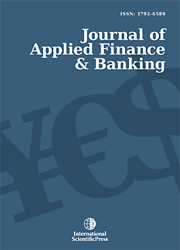Journal of Applied Finance & Banking
Did Two Banks Form a Herd? JP Morgan and the Bank of America
-
 [ Download ]
[ Download ]
- Times downloaded: 3
Abstract
We study the competitive behavior of the two largest US Banks before and after the financial crisis that started in 2007. The analysis documents that JP Morgan Chase, the initially smaller of the two rivals, followed a competitive strategy aiming to expand its lending to catch up with the leading private lender, the Bank of America. By contrast, the latter bank did not engage in an expansionary push to keep its quantitative advantage. Instead, it opted to diversify its lending portfolio and to invest in technological advances. This assessment is supported by econometric estimates and counterfactual simulations. With its strategy of quality over quantity the Bank of America refrained from engaging in herd behavior which could have led to a new upswing of the credit cycle.
JEL classification numbers: D22, E32, E7, G21.
Keywords: Herd Behavior, US Banks, Competitive Rivalry, Credit Cycle.
